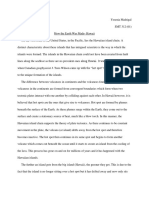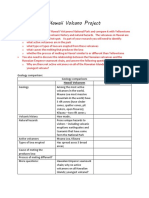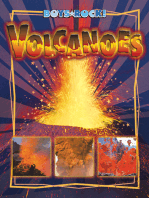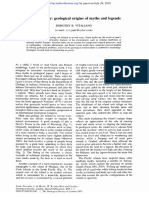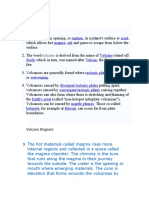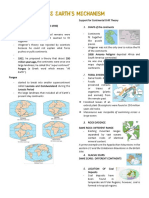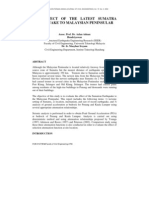0 ratings0% found this document useful (0 votes)
19 viewsHawaii Volcano Fun Facts Poster
Hawaii Volcano Fun Facts Poster
Uploaded by
Carla MaqThe Hawaiian Islands were formed by volcanic activity over a hot spot in the Pacific tectonic plate over 70 million years. As the plate moved over the hot spot, volcanoes erupted underwater and new islands were built up, creating the island chain. Active volcanoes continue to change the landscape today, producing lava flows and black sand beaches.
Copyright:
© All Rights Reserved
Available Formats
Download as PDF, TXT or read online from Scribd
Hawaii Volcano Fun Facts Poster
Hawaii Volcano Fun Facts Poster
Uploaded by
Carla Maq0 ratings0% found this document useful (0 votes)
19 views1 pageThe Hawaiian Islands were formed by volcanic activity over a hot spot in the Pacific tectonic plate over 70 million years. As the plate moved over the hot spot, volcanoes erupted underwater and new islands were built up, creating the island chain. Active volcanoes continue to change the landscape today, producing lava flows and black sand beaches.
Original Title
Hawaii-volcano-fun-facts-poster
Copyright
© © All Rights Reserved
Available Formats
PDF, TXT or read online from Scribd
Share this document
Did you find this document useful?
Is this content inappropriate?
The Hawaiian Islands were formed by volcanic activity over a hot spot in the Pacific tectonic plate over 70 million years. As the plate moved over the hot spot, volcanoes erupted underwater and new islands were built up, creating the island chain. Active volcanoes continue to change the landscape today, producing lava flows and black sand beaches.
Copyright:
© All Rights Reserved
Available Formats
Download as PDF, TXT or read online from Scribd
Download as pdf or txt
0 ratings0% found this document useful (0 votes)
19 views1 pageHawaii Volcano Fun Facts Poster
Hawaii Volcano Fun Facts Poster
Uploaded by
Carla MaqThe Hawaiian Islands were formed by volcanic activity over a hot spot in the Pacific tectonic plate over 70 million years. As the plate moved over the hot spot, volcanoes erupted underwater and new islands were built up, creating the island chain. Active volcanoes continue to change the landscape today, producing lava flows and black sand beaches.
Copyright:
© All Rights Reserved
Available Formats
Download as PDF, TXT or read online from Scribd
Download as pdf or txt
You are on page 1of 1
Volcanoes formed the Hawaiian Islands, but how?
1. The earth’s outer crust is broken
up into nine giant tectonic plates
that sit atop of magma.
Did you know? Magma is hot molten
rock in the interior of the earth.
Did you know? The Hawaiian Islands
were formed 70 million years ago.
2. Volcanoes typically form in
areas where tectonic plates come
together, but they can also form
in the middle of the plates, a
phenomenon known as Did you know? There are currently
“hot spot volcanism.” 6 active volcanoes on the islands of
Hawai’i and Maui: Kilauea, Mauna
Loa, Hualālai, Mauna Kea, Lō‘ihi, and
Haleakalā.
3. In the middle of the Pacific Tectonic
Plate, magma rose up and erupted on
the seafloor. As the plate moved over
the “hot spot,” it formed the Hawaiian
Islands.
Did you know? The Hawaiian Islands are
a chain of 132 islands that stretch over
1,500 miles.
4. Volcanoes continually change the
landscape. When they erupt, molten
lava rolls into the sea and the
crashing waves pulverize the
Let us take you and your students
on an amazing trip to experience the hardened rock along the shoreline,
world outside your class. From Alaska
and Iceland to Hawaii and Costa
creating black sand beaches.
Rica, you’ll discover action-packed
adventure, hands-on learning, and
non-stop scientific exploration that Did you know? Punalu’u beach is the
will open your students’ minds like
never before. Learn more today at
most famous black sand beach on the
worldstrides.com/science. Big Island of Hawaii.
®WorldStrides 2001-DSC-185592
You might also like
- How The Earth Was Made - HawaiiDocument3 pagesHow The Earth Was Made - Hawaiiapi-312004413No ratings yet
- Hawai'i Assignment Tectonic PlatesDocument7 pagesHawai'i Assignment Tectonic PlatesjohnosborneNo ratings yet
- Hawaii Volcano ProjectDocument5 pagesHawaii Volcano ProjectKaitlyn CabreraNo ratings yet
- Volcanoes in HawaiiDocument9 pagesVolcanoes in HawaiiJaredNo ratings yet
- All About Hawaiian Volcanoes: A Kid's Guide to Islands on Fire: Educational Books For Kids, #27From EverandAll About Hawaiian Volcanoes: A Kid's Guide to Islands on Fire: Educational Books For Kids, #27No ratings yet
- Ans Key CH 11 Volcanoes & TsunamiDocument3 pagesAns Key CH 11 Volcanoes & TsunamiAamir SirohiNo ratings yet
- ARTICULO JOSE DAVID SALAS InglesDocument4 pagesARTICULO JOSE DAVID SALAS InglesJOSE DAVID SALAS PERALTA (:-)No ratings yet
- Hot Spots Pele and Plate TectonicsDocument6 pagesHot Spots Pele and Plate Tectonicsapi-326730036No ratings yet
- Most of Volcanoes/ Earthquakes and Formation of Mountains Occurs Along With?Document63 pagesMost of Volcanoes/ Earthquakes and Formation of Mountains Occurs Along With?Imee TiloNo ratings yet
- Islands in The Maldives Were Expected To Vanish. Climate Science Tells Another Story. - The New York TimesDocument38 pagesIslands in The Maldives Were Expected To Vanish. Climate Science Tells Another Story. - The New York TimesAlexandre Rocha da SilvaNo ratings yet
- Hot SpotDocument15 pagesHot SpotCathlene GolpoNo ratings yet
- Khryssdale Saavedra Jacob - Hotspots-Story of PeleDocument9 pagesKhryssdale Saavedra Jacob - Hotspots-Story of PeleHenry JacobNo ratings yet
- Course Project Final (Geologic Field Trip Guide)Document6 pagesCourse Project Final (Geologic Field Trip Guide)Narmata GurungNo ratings yet
- Chapter 4: Volcanism: After Having Learnt This Chapter, You Should Be Able ToDocument4 pagesChapter 4: Volcanism: After Having Learnt This Chapter, You Should Be Able ToVaansh DhirwaniNo ratings yet
- Geomythology: Geological Origins of Myths and Legends: AbstractDocument7 pagesGeomythology: Geological Origins of Myths and Legends: AbstractalfredovNo ratings yet
- VOLCANESDocument10 pagesVOLCANESJahnisel A. CordovaNo ratings yet
- 5th Grade Science VolcanoesDocument3 pages5th Grade Science VolcanoesCOPYMIX STATIONNo ratings yet
- 1 Distribution of Volcanos in The WorldDocument42 pages1 Distribution of Volcanos in The Worldabdomg910No ratings yet
- E114 Volc Day2Document55 pagesE114 Volc Day2muhammadNo ratings yet
- Sites Where Volcanoes Are FoundDocument9 pagesSites Where Volcanoes Are FoundAdrienne BarrogaNo ratings yet
- Earthquakes Volcanoes BoltDocument487 pagesEarthquakes Volcanoes Boltzhangjingfei8No ratings yet
- VolcanoesDocument24 pagesVolcanoesBarbara BananaNo ratings yet
- Grade 10 Activity Sheets Quarter 1 Week 5-6Document14 pagesGrade 10 Activity Sheets Quarter 1 Week 5-6Nexie JunsayNo ratings yet
- مراجعة تانية اجتماعDocument9 pagesمراجعة تانية اجتماعAmr GamilNo ratings yet
- Mountains of Fire: Exploring the Science of Volcanoes: The Science of Natural Disasters For KidsFrom EverandMountains of Fire: Exploring the Science of Volcanoes: The Science of Natural Disasters For KidsNo ratings yet
- Volcano - WikipediaDocument25 pagesVolcano - WikipedialauskiNo ratings yet
- Islands (Tell Me Why #120) (gnv64)Document98 pagesIslands (Tell Me Why #120) (gnv64)Himadri Sarkar100% (1)
- What Happens Before and After Volcanoes Erupt? Geology for Kids | Children's Earth Sciences BooksFrom EverandWhat Happens Before and After Volcanoes Erupt? Geology for Kids | Children's Earth Sciences BooksNo ratings yet
- Hawaiian Hot SpotsDocument8 pagesHawaiian Hot SpotsshoaibnadirNo ratings yet
- Ch-1. Volcanism (SRB) - 26!10!20 DoneDocument65 pagesCh-1. Volcanism (SRB) - 26!10!20 Doneasmitsonkar8200No ratings yet
- Petrology of HawaiiDocument8 pagesPetrology of HawaiiFarhan RyandiNo ratings yet
- Deep Study On Mouna Kea: Susmita Mondal (Presidency University) Prajesh Kumar Roy (Bankura Sammilani College)Document11 pagesDeep Study On Mouna Kea: Susmita Mondal (Presidency University) Prajesh Kumar Roy (Bankura Sammilani College)Susmita Mondal100% (1)
- Science 10 1st Module Set BDocument42 pagesScience 10 1st Module Set BjulianimiguelvNo ratings yet
- Text 2Document2 pagesText 2sumeali1985No ratings yet
- How Do Volcanoes Form?: Popular StoriesDocument5 pagesHow Do Volcanoes Form?: Popular Storiesshuraj k.c.No ratings yet
- Traveller 3-Workbook-Module 4-Round UpDocument2 pagesTraveller 3-Workbook-Module 4-Round Upbayujatmiko91No ratings yet
- VolcanoesDocument49 pagesVolcanoesJuan Sebastian Bohorquez RozoNo ratings yet
- Reviewer Science 1st Semi-QuarterDocument9 pagesReviewer Science 1st Semi-QuarterEarl AndreiNo ratings yet
- FIRST TERM SSS 3 GEOGRAPHY NOTE_032057Document33 pagesFIRST TERM SSS 3 GEOGRAPHY NOTE_032057ealvin545No ratings yet
- E114 - Volc - Day2 - LP 2017W1Document62 pagesE114 - Volc - Day2 - LP 2017W1John GongNo ratings yet
- Geography Wa1 - EllipsisDocument5 pagesGeography Wa1 - EllipsisEllipsis Lilo LimNo ratings yet
- DLL Week 5 Day 1Document3 pagesDLL Week 5 Day 1Allynn JunioNo ratings yet
- Volcanoes The Ultimate Book: Experience the Heat, Power, and Beauty of VolcanoesFrom EverandVolcanoes The Ultimate Book: Experience the Heat, Power, and Beauty of VolcanoesNo ratings yet
- Earthquakes VolcanoesDocument253 pagesEarthquakes Volcanoeszhangjingfei8No ratings yet
- Science 8: Lagonoy High SchoolDocument3 pagesScience 8: Lagonoy High SchoolJohn Mark PrestozaNo ratings yet
- (Science) Types of Plate BoundariesDocument2 pages(Science) Types of Plate BoundariesdaniapslapulapuNo ratings yet
- Lesson1 PDFDocument4 pagesLesson1 PDFApril Rose Arnuza RazonableNo ratings yet
- HotspotDocument5 pagesHotspotmandeeppandey9643946544No ratings yet
- Level J - Discovering The Earth Hotspots - AK - AY2223Document3 pagesLevel J - Discovering The Earth Hotspots - AK - AY2223pp22hv5g75No ratings yet
- Science, Option 2Document4 pagesScience, Option 2alyssaNo ratings yet
- Continental Drift Theory NotesDocument3 pagesContinental Drift Theory NotesGirli JoseeNo ratings yet
- Geog 1 - FinalsDocument10 pagesGeog 1 - FinalsAlexie Anne MariñoNo ratings yet
- Volcano ReportDocument2 pagesVolcano ReportpichizzledNo ratings yet
- Reviewer GeoDocument4 pagesReviewer Geo07BUGAYONG, GERALDINE D.No ratings yet
- Lecture No. 4: The Earth'S MechanismDocument3 pagesLecture No. 4: The Earth'S MechanismGlenmar Alejandro VinegasNo ratings yet
- Ert SciDocument2 pagesErt SciBenedict De Los ReyesNo ratings yet
- Intro-EQ Final - 2023Document36 pagesIntro-EQ Final - 2023MISKIR TADESSENo ratings yet
- Futura: Engineering InternshipDocument7 pagesFutura: Engineering InternshipDoinkyNo ratings yet
- ELSci Q1 Lesson 10 - Earthquakes, Volcanic Eruptions, and LandslidesDocument37 pagesELSci Q1 Lesson 10 - Earthquakes, Volcanic Eruptions, and LandslidesItsClarenceNo ratings yet
- Volcanoes and EarthquakesDocument21 pagesVolcanoes and EarthquakesLeo DionedaNo ratings yet
- Unit 4 Volcanic Hazard Volcano: Cinder Cone VolcanoesDocument5 pagesUnit 4 Volcanic Hazard Volcano: Cinder Cone VolcanoesChristina UyNo ratings yet
- Christchurch Earthquake Case StudyDocument2 pagesChristchurch Earthquake Case StudyMokYikLamNo ratings yet
- The Effect of The Latest Sumatra Earthquake To Malaysian PeninsularDocument12 pagesThe Effect of The Latest Sumatra Earthquake To Malaysian PeninsularSuzana C. AlihNo ratings yet
- Chapter - 7 Geography Class Ix Volcanoes: I. Match The FollowingDocument3 pagesChapter - 7 Geography Class Ix Volcanoes: I. Match The FollowingAyushmanNo ratings yet
- Type of Soil Support Zone, Z Importance Factor, IDocument7 pagesType of Soil Support Zone, Z Importance Factor, IPrayas SubediNo ratings yet
- VolcanoesDocument14 pagesVolcanoesSHANNEL ANN VILLUGANo ratings yet
- LKPD News Item Siklus 3 P1Document5 pagesLKPD News Item Siklus 3 P1elvianayunita18No ratings yet
- 1.4. Seismicity of The Philippines - CE 305Document9 pages1.4. Seismicity of The Philippines - CE 305Anonymous 09No ratings yet
- Vulcanism Vulcanicity-Vulcan (Roman) - God of FireDocument12 pagesVulcanism Vulcanicity-Vulcan (Roman) - God of FiretrevorNo ratings yet
- Classification of Volcanic Eruption and Lab2Document15 pagesClassification of Volcanic Eruption and Lab2Collene BorantesNo ratings yet
- Björnsson Et Al. 1979Document10 pagesBjörnsson Et Al. 1979katy77barlowNo ratings yet
- Kunci Jawaban:: Kriteria Skor NilaiDocument1 pageKunci Jawaban:: Kriteria Skor NilaiPhuan S AyuNo ratings yet
- Activity: A Fiery History 1. Mount Mayon - AlbayDocument6 pagesActivity: A Fiery History 1. Mount Mayon - AlbayJM RasNo ratings yet
- SLM 4TH Quarter Module 2 TeacherDocument20 pagesSLM 4TH Quarter Module 2 TeacherCALMAREZ JOMELNo ratings yet
- Unit Test in Earthquakes and Faults 1920Document4 pagesUnit Test in Earthquakes and Faults 1920anthony t. avilesNo ratings yet
- DBC - M 4 NewDocument2 pagesDBC - M 4 Newyenyenine135No ratings yet
- Lesson - 14 When The Earth Shook SupplementaryDocument7 pagesLesson - 14 When The Earth Shook SupplementarySubodh Kumar singhNo ratings yet
- Class:-IX Geography, Chapter-8 A. Answer The Following QuestionsDocument3 pagesClass:-IX Geography, Chapter-8 A. Answer The Following QuestionsVindhya SriNo ratings yet
- Muet ReadingDocument7 pagesMuet ReadingRoRo RoRoNo ratings yet
- PIANC - Mitigation of Tsunami Disasters in Ports - Wg5354Document114 pagesPIANC - Mitigation of Tsunami Disasters in Ports - Wg5354Ryan ColemanNo ratings yet
- Earthquake NotesDocument2 pagesEarthquake NotesElyenNo ratings yet
- Identify The Generic Structure and Language Features of A News StoryDocument5 pagesIdentify The Generic Structure and Language Features of A News StoryArya PratamaNo ratings yet
- S6 - Q4 - Week 1Document11 pagesS6 - Q4 - Week 1Corazon Diong Sugabo-TaculodNo ratings yet
- Phivolcs Earthquake PresentationDocument53 pagesPhivolcs Earthquake PresentationGodino ChristianNo ratings yet
- UB - SutamiDocument12 pagesUB - SutamiakahaaNo ratings yet
- 9.4 Geohazard PhenomenonDocument27 pages9.4 Geohazard PhenomenonEmily Ti Er ChiNo ratings yet
